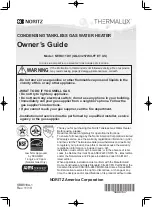
41
GAS ORIFICE
BURNER
IGNITER
GAS VALVE
Figure 68. Burner/Gas Train
Combustion Blower Removal
1. Shut off main electrical power switch to heater.
2. Shut off gas upstream of heater.
3. Remove top cover.
4. Disconnect gas line from gas valve by unscrewing
union fitting along the gas train.
5. Disconnect the supply power connector from the
blower.
6. Disconnect 24V power leads from gas valve.
7. Remove suction hoses from the venturi and blower.
8. Use M10 socket to remove (4) nuts from base of the
blower. Then lift and remove blower.
Gas Valve Removal
1. Shut off gas supply to heater.
2. Remove top cover.
3. Unscrew the union fitting on gas train.
4. Remove the 24V power leads from the gas valve.
5. Remove tracking hose from the gas valve to the
venturi.
6. Use a pipe wrench to hold the other end of the gas
train (pipe connected to blower), while using another
pipe wrench to torque the gas valve counterclockwise
and remove from assembly. Alternatively, you can
remove the gas orifice flange to access the valve gas
train.
Heat Exchanger Removal
1. Shut off water, gas, and power to unit. Release
any pressure in water lines. Then remove water
connections to heater.
2. Remove top cover. Disconnect power leads from
rocker switch along with the cable attached to the
user interface. Then set cover aside. (*It will be easier
to work on heater with the cover totally removed but
might not be necessary*).
3. Perform the steps in “Combustion Blower Removal”.
4. Use Philips head screwdriver to remove screws from
all jacket panels.
5. Use a Philips head screwdriver to remove (8)
machine screws along the side of the combustion
chamber (there are 4 on each side), and the two (2)
sheet metal pieces that hold the combustion box to
the side panels.
6. Carefully lift top combustion chamber from the base
and remove it from the heater.
7. Use ½” socket to remove (8) nuts from the side
brackets that hold the heat exchanger onto the base
(there are 2 nuts per bracket).
8. Use a crescent wrench to remove the (2) water
temperature sensors on the side of the main header.
9. Remove the (4) wire leads connected to the high limit
switches.
10. Lift the heat exchanger and remove from unit.
Tube Cleaning Procedure
Establish a regular inspection schedule, the frequency
depending on the local water conditions and the severity
of service. Do not let the tubes clog up solidly. Clean out
deposits over 1/16" (1.6 mm) in thickness.
The heater may be cleaned from the return header
side, without breaking pipe connections. It is preferable,
however, to remove both headers for better visibility
through the tubes and to be sure the ground-up lime dust
does not get into the system.
After reaming, mount the wire brush in place of the auger
and clean out debris remaining in the tubes.
Another method is to remove the heat exchanger, ream
tubes and immerse heat exchanger in non-inhibited
de-scale solvent for severe scale build-up.
Extension
Pieces (2)
Auger
with Carbide Tip
Wire Brush
Figure 69. De-Liming Cleaning Kit (#052871F)
Desooting Procedure
A
WARNING:
Soot Is Combustible. Exercise Extreme
Care.
Soot will clog areas between fins and cause eventual
tube failure. Any sign of soot at the base of the burners or
around the outer jacket indicates a need for cleaning.
Summary of Contents for AVIA 264A
Page 67: ...67 2 H 1 R 1 H 7 S 2 C 3 C 5 S...
Page 68: ...68 1 F 2 F 2 G 1 M 4 M 5 M 6 M 7 M 8 M 10 M 6 G 3 G 4 G...
Page 69: ...69 1 B 2 B 2 F 1 P 3 P 2 P...
Page 70: ...70 1 V 2 V 3 V 11C 11 M OPTIONAL...
Page 71: ...71 14 H 15 H 4 H 12 M 7 H 9 H 7 C 8 C 12 H 13 H 16 H 11 H 10 H 10 C 9 C 8 H 6 H 5 H 3 H...
Page 146: ...67 2 H 1 R 1 H 7 S 2 C 3 C 5 S...
Page 147: ...68 1 F 2 F 2 G 1 M 4 M 5 M 6 M 7 M 8 M 10 M 6 G 3 G 4 G...
Page 148: ...69 1 B 2 B 2 F 1 P 3 P 2 P...
Page 149: ...70 1 V 2 V 3 V 11C 11 M OPTIONAL...
Page 150: ...71 14 H 15 H 4 H 12 M 7 H 9 H 7 C 8 C 12 H 13 H 16 H 11 H 10 H 10 C 9 C 8 H 6 H 5 H 3 H...
















































